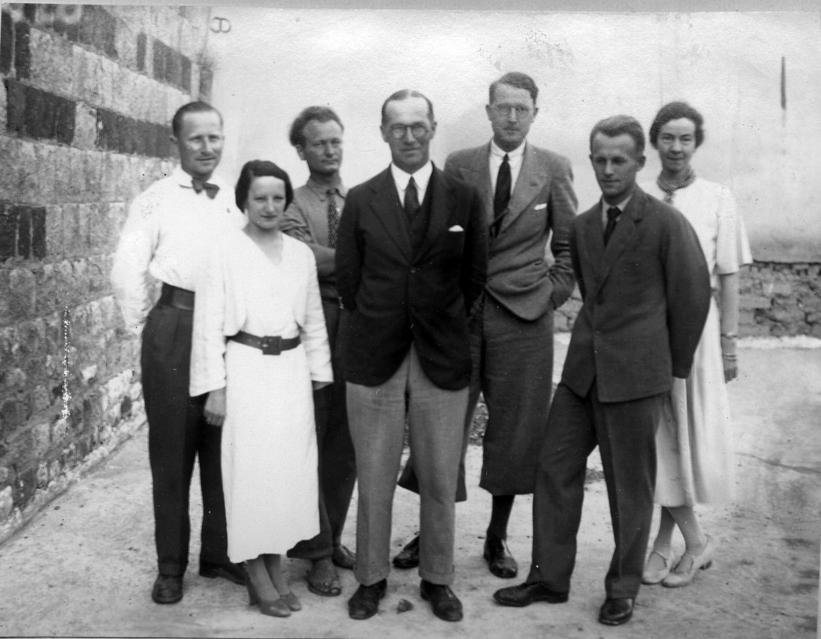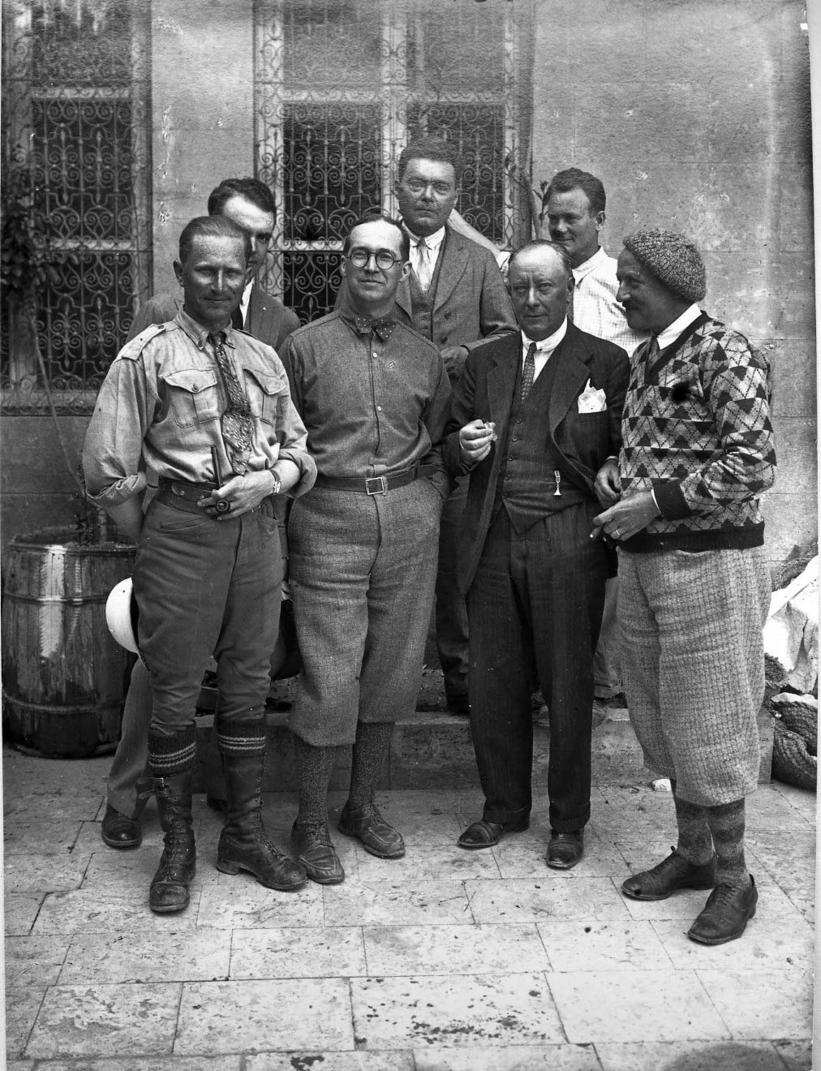The Members of the Expedition

Christensen, Charles (1886-1959)
• Served as an architect during the 1931 season.
• Graduated with a degree in architecture in 1916 from The Royal Danish Academy of Fine Arts.
Christensen took part in surveys and renovations of historical buildings for, among others, the Danish Interior Ministry, and was employed in the Medieval Department at the National Museum from 1919 on. He also wrote a number of works on architectural history.
Christian, Victor (1885-1963)
• Served as an archaeologist during the 1935 season.
Christian was an Austrian archaeologist employed at the University of Vienna, with a specialty in the study of the Sumerian Period in Mesopotamia.
Day, Florence
• Served as an archaeologist during the 1933 season.
Day was an American archaeologist, born in Beirut in Lebanon, where she would later work in the Archaeological Museum at the American University of Beirut (AUB). In the 1930s she also participated in Hetty Goldman’s excavations at Tarsus-Gözlüküle, in Southern Turkey. Day specialized in Islamic Art and later served as a curator in the Department of Near Eastern Art at the Metropolitan Museum in New York.
Elo, Mathilius Schack (1887-1948)
• Served as a conservator during the 1931 season.
• Elo was a sculptor and was trained as a conservator by his father and also received training overseas.
Elo took over his father’s position as conservator at the Ny Carlsberg Glyptotek Museum in Copenhagen, where he made improvements on his father’s method of removing salts from limestone. This development contributed to stopping the deterioration of a large part of the Egyptian collection at the museum. He travelled throughout Europe and took part in Dr. Fr. Poulsen’s expeditions to Greece.
Elo took part in mending and restoring many archaeological artifacts, including the Hama lion, which stood in the courtyard of the National Museum until it was sent back to Syria.
As a sculptor, Elo exhibited in Denmark and France. He specialized in portrait busts, especially of children.
Fugmann, Ejnar Leo (1896-1965)
• Served as chief architect for the entire length of the expedition, from 1931 to 1938.
• Fugmann was originally trained as a bricklayer and later attended Copenhagen Technical College and The Royal Danish Academy of Fine Arts from 1914 to 1927.
In the beginning of the 1920s, Fugmann undertook study trips to England, France, Italy, and Germany. In the 1930s, he spent time in Syria, Egypt, Palestine, Greece, Turkey, and Italy.
Fugmann was responsible for much of the architectural measurements and drawings. He worked to improve the drawings of architecture and artifacts in order to make them as accurately measured and professionally drawn as possible. He also painted many watercolours of the old town of Hama, which have served as important documentation of a place that has regrettably mostly disappeared. Over time he became a leading figure in the project alongside its director, Harald Ingholt. His main publication is of the pre-Hellenistic Periods of occupation at Hama.
Fugmann was employed by Holmen’s Building Administration and designed the pavilion in The Royal Shooting Society’s garden. He also designed industrial buildings and family homes, as well as furniture, carpets, and silverware.
Hjortsø, Leo Erwyn (1909-1996)
• Participated in the excavations during the 1935 season.
• Hjortsø had a degree in Greek and Latin and was for many years a teacher of classical studies at Ålborg Cathedral School. Later he became a lecturer in Classical Philology at the University of Copenhagen (1968-78).
In addition to teaching, his translations of classical Greek literature served to popularize this material within the broader Danish society. He also wrote handbooks on Greek and Roman mythology, as well as a series of books on Greek art and theater.
Hornemann, Bodil
• Served as photographer from 1932 to 1938.
Hornemann was a sculptress and was connected to the Ethnographic Collection at the National Museum. Among other tasks there, she modeled heads from the life masks of Mongols that had been collected by the Hastlund-Christensen expedition.

Ingholt, Kai Harald (1896-1985)
• Leader of the Hama Expedition during its entirety.
• Ingholt studied Semitic and Oriental Philology at The University of Copenhagen. He also studied in Paris and at Yale University before receiving his Ph.D. in 1928.
Ingholt took part in the excavations at Palmyra, in Syria, in the 1920s, and his doctoral dissertation was on the sculpture from that important site. He served as Assistant Director of the Ny Carlsberg Glyptotek Museum from 1925 to 1930, and was Secretary of the Carlsberg Foundation from 1927 to 1930.
For the duration of the Hama excavations, Ingholt was employed as a lecturer in archaeology at the American University of Beirut, as well as curator at the AUB Archaeological Museum. In 1941 he became Professor of Hebrew at Århus University. From 1942 until his retirement in 1964 he served as Professor of Archaeology at Yale University.
Ingholt was one of the first to write about the archaeology of Syria and he laid the foundation for the study of Near Eastern Archaeology in Denmark. He also wrote extensively on the art of Gandhara, in Northwestern Pakistan. He received many accolades, including the Order of the Dannebrog, one of Denmark’s highest honors.
As an excavation director, Ingholt was known as both a knowledgeable and amiable leader – always in good humor and possessing great diplomatic skills. He was able to get along well with people of all nationalities and walks of life. The Hama Project was known as the only excavation in the Levant at the time in which the participants weren’t “at each other’s throats”, as a source related to Poul Jørgen Riis in his book, Hama: Danske arkæologersudgravningeri Syrien.
Jensen, Frode
• Served as a conservator and in other assorted jobs for the duration of the project, from 1931 to 1938.
• He was a trained house painter and probably a self-taught conservator.
Jensen had extensive experience of working in the Near East.
Poulsen, Vagn (1909-1970)
• Participated as an archaeology student during the seasons of 1931 and 1932.
• Poulsen received a Ph.D. in Classical Archaeology from The University of Copenhagen in 1937.
Poulsen began working as an assistant at the Ny Carlsberg Glyptotek in 1936. He went on to become a curator and then director of the museum for 27 years, until his death. His work at the museum stood out as a model for a number of European museums. In addition to new ways of displaying museum objects, Poulsen took various measures to improve the museum’s relationship with its patrons through various events, such as concerts, guided tours, and lectures.
Poulsen took many study trips to Italy, Greece, and Turkey before and after the Second World War. He was an expert on Greek and Roman portrait sculpture, especially, and he published many works on various topics, including on the Medieval Islamic pottery from Hama.
He began his university studies in art history, an interest he continued to cultivate alongside his work in archaeology and which led to the publication of a series of popular books on the subject.
He also served as secretary of the Carlsberg Foundation and as a board member for the C.L. Davids Fund and Collection.
Poulsen was known throughout his working life as a humanist with wide ranging interests and engagement.
Riis, Poul Jørgen (1910-2008)
• Served as an archaeologist in the seasons from 1931 to 1932 and 1936 to 1937.
• Riis studied at the Swedish Archaeological Institute in Rome and received his Ph.D. in Classical Archaeology from The University of Copenhagen in 1941.
Riis was employed in the Department of Classical and Near Eastern Antiquities at the National Museum in 1938, became a curator in 1940, and director of the department from 1941 to 1949. He served as a professor of classical archaeology at Århus University from 1949 to 1956, and then at The University of Copenhagen from 1956 to 1975.
From 1958 to 1963, Riis led the Carlsberg Foundation expedition to Tell Sukas, on the coast of Syria. He published excavation reports about the Sukas Project, as well as many volumes of the Hama excavation reports.
Riis also studied Etruscan art and served as an editor of several Danish journals.
In 2004, he published his autobiography, Erindringen fra en anden verden, in which, among other topics, he wrote about the many great personalities he met during his professional career.
Rohweder, Jørgen (1904-1994)
• Served as an architect during the 1932 and 1933 campaigns.
• Rohweder graduated in 1929 from the Royal Danish Academy of Fine Arts with a degree as an architect.
He travelled throughout Europe and the Middle East, and he established his own studio in Copenhagen in 1930. He designed many villas, summer houses, and larger buildings, especially on Sealand and around Copenhagen. He also designed furniture, including wicker furniture.
Scott, Nora (1905-1994)
• Served as an archaeologist during the 1933 campaign.
• Scott received degrees from Barnard College, in New York City, and Oxford.
Scott, a Scottish-American archaeologist, also took part in the excavations at the site of Armant, south of Luxor in Egypt, in 1929 and 1930. She was employed at the Metropolitan Museum in New York City, where she became Curator of the Department of Egyptian Art in 1968.
Tchalenko, Georges
• Served as an architect for the seasons of 1934 to1935, and 1938.
Tchalenko was a Russian architect and expert on Byzantine church architecture. In the 1930s and 1940s, he led an expedition to study the Roman-Byzantine “dead cities” in Northern Syria.
He also assisted with restoration work at Hama.
